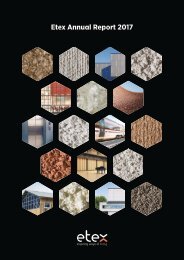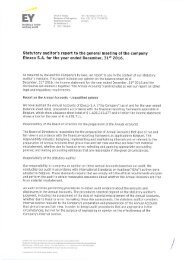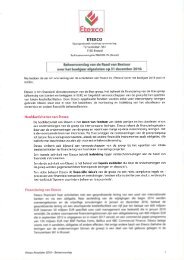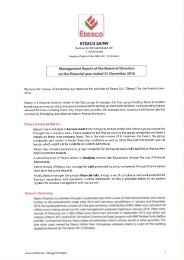ETX-10829_Etex-AR2017_WEB_2018_DEF2 (2)
You also want an ePaper? Increase the reach of your titles
YUMPU automatically turns print PDFs into web optimized ePapers that Google loves.
6.1<br />
Financial report<br />
Consolidated financial statements<br />
<strong>Etex</strong> Annual Report 2017<br />
Financial report<br />
Consolidated financial statements<br />
Cash flow hedge<br />
Changes in the fair value of derivatives that are designated and qualify as cash flow hedges and that are effective are recognised in<br />
equity. Where the firm commitment results in the recognition of a non-financial asset, for example property, plant equipment or inventory,<br />
or a non-financial liability, the gains or losses previously recognised in equity are transferred from equity and included in the initial<br />
measurement of the non-financial asset or liability. Otherwise, amounts recognised in equity are transferred to the income statement and<br />
classified as revenue or expense in the same periods during which the cash flows, such as interest payments, or hedged firm<br />
commitments, affect the income statement. Any ineffective portion is reported immediately in the income statement. When a hedging<br />
instrument is sold, or when a hedge no longer meets the criteria for hedge accounting, any cumulative gain or loss existing in equity at<br />
that time remains in equity and is recognised when the committed transaction ultimately is recognised in the income statement. However,<br />
if a committed transaction is no longer expected to occur, the cumulative gain or loss that was reported in equity is immediately<br />
transferred to the income statement.<br />
Net investment hedge<br />
Foreign currency differences arising on the retranslation of a financial liability designated as a hedge of a net investment in a foreign<br />
operation that are effective, are recognised in equity and included in cumulative translation differences. The amounts deferred in equity<br />
are transferred to the income statement on disposal of the foreign entity.<br />
Certain derivative transactions, while providing effective economic hedges under the Group’s risk management policies, may not qualify<br />
for hedge accounting. Changes in the fair value of any derivative instruments that do not qualify for hedge accounting are recognised<br />
immediately in the income statement. The changes in fair value that are recognised in profit and loss of the period are classified in<br />
operating result if the derivative relates to a non-financial asset and in financial result if the derivative relates to a financing transaction.<br />
T - Income taxes<br />
Income taxes include current and deferred income taxes.<br />
Current income taxes<br />
Current tax is the expected tax payable on taxable income for the year, and any adjustment to tax payable in respect of previous years.<br />
Current income tax assets and liabilities for the current and prior periods are measured at the amount expected to be recovered from or<br />
paid to the taxation authorities. The tax rates and tax laws used to compute the amount are those that are enacted or substantively<br />
enacted at the reporting date.<br />
Additional income taxes that arise from the distribution of dividends are recognised at the same time as the liability to pay the related<br />
dividend.<br />
Deferred income taxes<br />
Deferred income taxes are calculated, using the balance sheet liability method, on all temporary differences arising between the carrying<br />
amounts of assets and liabilities in the consolidated statement of financial position and their tax base. The amount of deferred tax provided<br />
is based on the expected manner of realisation of the carrying amount of assets and liabilities, using the tax rates enacted or substantially<br />
enacted at the reporting date.<br />
Deferred tax liabilities are recognised, except:<br />
– where the temporary differences arise from the initial recognition of goodwill or the initial recognition of an asset or liability in a<br />
transaction that affects neither accounting profit nor taxable profit on that date.<br />
– in respect of taxable temporary differences associated with investments in subsidiaries, equity accounted investees and interest<br />
in joint ventures, where the timing of the reversal of the temporary differences can be controlled and it is probable that the<br />
temporary differences will not reverse in the foreseeable future.<br />
Deferred tax assets are recognised only when it is probable that taxable profits will be available in the coming 3 years, against which the<br />
deductible temporary difference or the tax loss to be carried forward can be utilised, except:<br />
– where the temporary differences arise from the initial recognition of an asset or liability in a transaction that affects neither<br />
accounting profit nor taxable profit on that date.<br />
– in respect of deductible temporary differences associated with investments in subsidiaries, equity accounted investees and<br />
interest in joint ventures, deferred tax assets are recognised only to the extent that it is probable that the temporary differences<br />
will reverse in the foreseeable future and taxable profit will be available against which the temporary differences can be utilised.<br />
Deferred tax assets are reviewed at each reporting date to assess the probability that sufficient taxable profit will be available to allow<br />
deferred taxes to be utilised.<br />
Deferred tax is recognised in the income statement, except when it relates to items credited or charged directly to equity, in which case<br />
the deferred tax is treated accordingly.<br />
Deferred tax assets and liabilities are offset, if a legally enforceable right exists to set off current tax assets against current tax liabilities<br />
and the deferred taxes relate to the same taxable entity and the same tax authority.<br />
U - Revenue<br />
Revenue is recognised at the amount that reflects the consideration to which the Group expects to be entitled in exchange for transferring<br />
goods or services to a customer.<br />
Sales of goods<br />
Revenue from sales of goods is recognised in the income statement net of sales taxes and discounts when revenue recognition occurs,<br />
being at a point in time when control of the asset is transferred to the customer, generally on delivery of the goods.<br />
Construction contracts<br />
A limited number of activities of the Group are construction contract driven. Consequently contract revenue and contract costs are<br />
recognised in the income statement on the percentage-of-completion method, with the stage of completion being measured by reference<br />
to actual work performed to date. When the outcome of a construction contract cannot be estimated reliably, contract revenue is<br />
recognised only to the extent of the contract expenses that are recoverable. In the period in which it is determined that a loss will result<br />
from the performance of a contract, the entire amount of the estimated ultimate loss is charged to the income statement.<br />
Rental income<br />
Rental income arising on investment properties is accounted for on a straight-line basis over the lease terms on ongoing leases.<br />
Interest income<br />
Interest is recognised on a time proportion basis that reflects the effective yield on the asset.<br />
Dividends<br />
Dividends are recognised when the Group’s right to receive payment is established.<br />
<strong>Etex</strong> Annual Report 2017 p. 19<br />
<strong>Etex</strong> Annual Report 2017 p. 20<br />
114 115
















